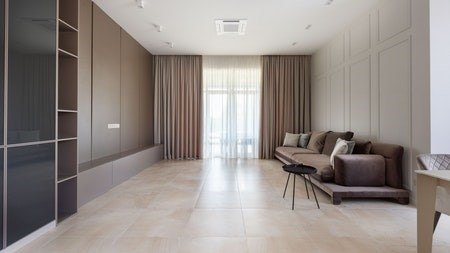The floors in your home must be able to withstand a lot of foot traffic, especially if you have pets or children.
Flooring which is suitable for the main bedroom is not necessarily the right choice for an open plan living area or children’s playroom. Hardwood or wall-to-wall carpets may work well in one room but wouldn’t do elsewhere in the home.
If you’re considering new flooring, you’ll need to think about how each room is used before making any decisions. In addition to your specific tastes, you need to take the following factors into account when selecting flooring for your home:
Architectural design
Durability
Comfort
Eco-friendliness
Home design
The first aspect to consider is the layout of your home. Using the same flooring throughout an open plan space will create a clean, continuous look, On the other hand, tiles or vinyl in the kitchen are more practical than carpeting. So, if you choose to carpet the lounge and dining areas be sure to choose kitchen flooring that harmonises with the adjoining spaces.
Choosing lighter-coloured flooring to complement your furniture can expand the perceived size of any room and can open up space. Good examples are cream-coloured carpets, tiles in natural and neutral tones, and whitewashed or grey wood flooring.
Durability
Keep in mind expected wear and tear, depending on where you’re planning to install the new flooring.
Popular highly durable options include hardwood flooring, ceramic, and porcelain tiles, laminate flooring, vinyl and carpets.
Porcelain and ceramic tiles are among the longest-lasting flooring materials available and require little maintenance. Tile floors are also moisture resistant, making them ideal for kitchens, bathrooms, and sculleries.
Vinyl is an inexpensive, waterproof, scratch and stain-resistant flooring that is also comfortable underfoot. It requires little upkeep and maintenance, is easy to clean, and is ideal if you have dogs.
Hardwood floors are durable and just need sweeping or vacuuming and occasional cleaning with a wood floor cleaner. However, hardwood floors in high traffic areas will be prone to scratches, especially if you have pets or children.
New technologies have made carpets more durable with longer life spans, improved colour-fastness, and superior stain resistance. The key is picking and maintaining the right carpet for your home and lifestyle. For example, a dense short pile carpet is best for high-traffic areas.
Properly sealed concrete floors are tough and attractive. This surface resists scratches, water, and stains and won’t harbour mould or mildew. It can also be tinted with any colour or painted to look like wood or tile.
Comfort
Comfortable flooring materials are essential for rooms where you and your family spend a lot of time standing, such as in the kitchen, and if you have small children who spend a lot of time playing on the floor. Good choices are vinyl for kitchens and carpets for children’s rooms.
Eco-friendly options
Carpets can be eco-friendly with some being made from natural fibres and recycled materials, like plastic bottles.
Cork is one of the most environmentally-friendly flooring options and also has many other benefits.
It’s easy on the feet, thanks to microscopic air pockets that create a cushioning effect.
It’s sustainably harvested. Cork flooring is made from cork oak bark, which does not harm the tree and eventually grows back.
Cork flooring doesn’t harbour dust and pollen and resists bacteria and fungi.
Cork is water-resistant but not waterproof, so it needs to be sealed every few years to help protect it from any standing water. When selecting sealers or adhesives opt for low- or no-VOC products.
Choosing flooring entails more than just finding the most attractive or least expensive product. It is well worth taking the time and making the effort to select the right products for your requirements.



